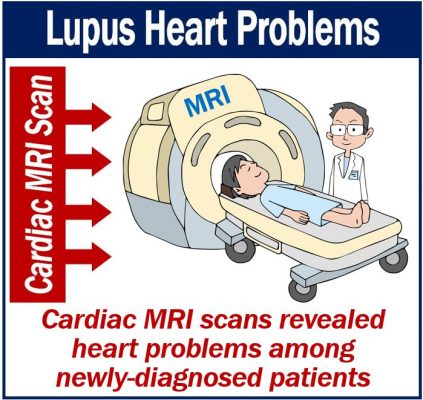Many newly-diagnosed lupus patients have the warning signs of potential heart problems, a team of scientists in China discovered. Heart problems are more common among patients with lupus compared to the general population. In fact, for lupus patients, heart problems are the leading cause of death.
Team leader Dr. Jun Pu and colleagues wrote about their study and findings in the journal Arthritis & Rheumatology (citation below). Dr. Pu works at the Department of Cardiology, Renji Hospital, School of Medicine Shanghai, Jiaotong University, Shanghai, China.
The researchers used imaging tests which showed that many newly-diagnosed lupus patients had cardiac impairment. They even detected signs of heart problems among patients with no signs of cardiac impairment. Chest discomfort, for example, is a common sign.

A cardiac MRI can reveal early signs of heart problems that doctors might otherwise have overlooked. The scans showed that newly-diagnosed lupus patients had signs of heart problems. Therefore, doctors should order routine cardiac MRIs for newly-diagnosed patients.
Detecting heart problems – Cardiac MRI
The researchers used Cardiac MRI or Cardiovascular Magnetic Resonance Imaging to detect heart problems. Cardiac MRI is an imaging technology for non-invasive assessment of the structure and function of the cardiovascular system. It also assesses the tissue characterization of the cardiovascular system.
Their study included 160 participants. Fifty patients had been recently diagnosed with lupus. Another sixty were established lupus patients. The other fifty were ‘healthy.’ In this context, ‘healthy’ means they did not have lupus.
Lupus and heart problems
Using cardiac MRIs, Dr. Jun Pu and colleagues revealed that many of the lupus patients had heart problems. They also showed that heart problems were directly related to their stage of their disease.
In the hearts of the lupus patients, the authors detected signs of scarring. The images also showed evidence of fibrosis.
Recommend routine cardiac MRI tests
Lupus patients do not currently undergo routine cardiac MRI tests. However, some early signs of heart problems are not typically detectable without cardiac MRI.
Therefore, if patients underwent cardiac MRI scans, their early heart problems would be detected. They could subsequently receive treatment that would prevent further damage to the heart.
In an Abstract that precedes the main article in the journal, the authors wrote:
“The structural and functional changes in the myocardium were related to the SLE stage; this finding indicates the value of the early detection of myocardial involvement.”
“Native myocardial T1 values and ECV, rather than current clinical rheumatic and cardiac indices, could serve as early detection markers of myocardial injury before the presence of visual fibrosis and functional decompensation.”
Citation
‘Early Detection of Silent Myocardial Impairment in Patients with New Onset Drug‐Naïve Systemic Lupus Erythematosus – A Three‐Center Prospective Study (Myocardial Impairment in New Onset SLE),’ Qiang Guo, Lian‐Ming Wu, Zi Wang, Jia‐Yan Shen, Xuan Su, Chang‐Qian Wang, Xing‐Rong Gong, Qing‐Ran Yan, Qing He, Wei Zhang, Jian‐Rong Xu, Meng Jiang, and Jun Pu. Arthritis & Rheumatology. First published: 02 August 2018. DOI: https://doi.org/10.1002/art.40671.
About lupus
Lupus is a chronic, systemic, autoimmune disease. This means it is a long-term disease (chronic) in which the body’s immune system attacks itself (autoimmune).
Affects whole body – systemic
It is also a disease that affects the whole body or many parts of the body. Hence, the term ‘systemic.’ The medical term for lupus is Systemic Lupus Erythematosus or SLE.
Causes – we are not sure
We suspect that lupus onset is due to hormonal, genetic, and environmental factors. Maybe when the factors are combined, some people become more susceptible. However, nobody is sure.
Air pollution and sunlight exposure, for example, are environmental factors.
Signs, symptoms, and diagnosis
Patients with lupus may have many different possible signs and symptoms. Doctors say that no two cases are ever the same. Therefore, it is a difficult disease to diagnose quickly.
Stiffness, joint pain, and fatigue are common symptoms. Heart problems and rashes are also common.
Treatment
As there are many possible symptoms, there are also many possible treatments. Treatment depends on what the patient’s symptoms are.
For example, if the patient has skin problems, treatment may include skin ointments and staying away from direct sunlight. The doctor will prescribe heart medications if the patient has heart problems.
The lupus pharmaceutical market’s huge size is due to the variety of symptoms patients may have and the different medications that doctors may prescribe.
Affects more women than men
Lupus affects significantly more women than men, but we do not know exactly why.
Chandra Mohan, a lupus researcher at the University of Houston, received a $2 million grant from the NIH. NIH stands for National Institutes of Health. He aims to find out why.
Lupus-specific medications
Over the past six decades, the FDA has approved just one lupus-specific drug. A recent Phase 2 trial of Baricitinib showed promise for lupus patients with arthritis or a skin rash.
